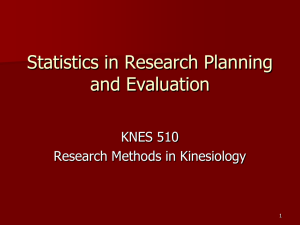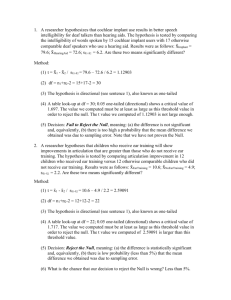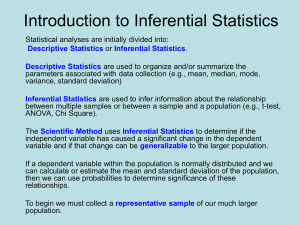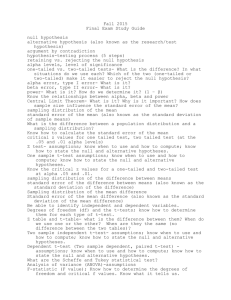Normal Curve, Probabilities, and Hypothesis Testing
advertisement
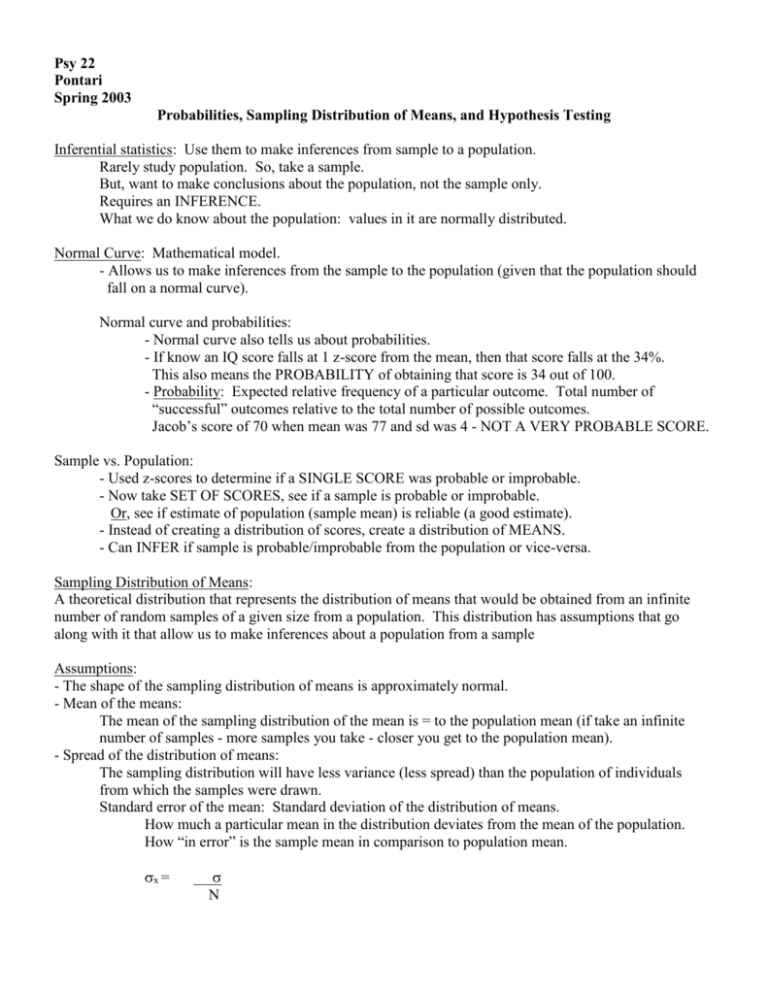
Psy 22 Pontari Spring 2003 Probabilities, Sampling Distribution of Means, and Hypothesis Testing Inferential statistics: Use them to make inferences from sample to a population. Rarely study population. So, take a sample. But, want to make conclusions about the population, not the sample only. Requires an INFERENCE. What we do know about the population: values in it are normally distributed. Normal Curve: Mathematical model. - Allows us to make inferences from the sample to the population (given that the population should fall on a normal curve). Normal curve and probabilities: - Normal curve also tells us about probabilities. - If know an IQ score falls at 1 z-score from the mean, then that score falls at the 34%. This also means the PROBABILITY of obtaining that score is 34 out of 100. - Probability: Expected relative frequency of a particular outcome. Total number of “successful” outcomes relative to the total number of possible outcomes. Jacob’s score of 70 when mean was 77 and sd was 4 - NOT A VERY PROBABLE SCORE. Sample vs. Population: - Used z-scores to determine if a SINGLE SCORE was probable or improbable. - Now take SET OF SCORES, see if a sample is probable or improbable. Or, see if estimate of population (sample mean) is reliable (a good estimate). - Instead of creating a distribution of scores, create a distribution of MEANS. - Can INFER if sample is probable/improbable from the population or vice-versa. Sampling Distribution of Means: A theoretical distribution that represents the distribution of means that would be obtained from an infinite number of random samples of a given size from a population. This distribution has assumptions that go along with it that allow us to make inferences about a population from a sample Assumptions: - The shape of the sampling distribution of means is approximately normal. - Mean of the means: The mean of the sampling distribution of the mean is = to the population mean (if take an infinite number of samples - more samples you take - closer you get to the population mean). - Spread of the distribution of means: The sampling distribution will have less variance (less spread) than the population of individuals from which the samples were drawn. Standard error of the mean: Standard deviation of the distribution of means. How much a particular mean in the distribution deviates from the mean of the population. How “in error” is the sample mean in comparison to population mean. x = N **With these assumptions, can determine if a sample is a reliable representation of the population. Sampling distribution of means is the distribution to which the sample mean can be compared - is sample mean likely? Probable? Example: Investigated hours studied per week of college students. - Have mean of population (somehow) and took infinite number of samples from population. Determined: = 12 From one sample: X = 11.7 Draw the curve. What else do we need to know? x = .4 - Find z-score: Before: X - X Now: X - μ s x Z = ??? What % does this value coincide with? This also means p = What is the probability that this sample mean would be found? Is 11.7 an “improbable” sample mean? What percentage of sample means would miss the population mean as much as 11.7? (careful….) What would make a sample mean more/less likely? But - we rarely have the population values for the mean or standard error. - Typically use sample mean to estimate population mean. What finally determines if a mean is probable/improbable? What determines if the sample mean is “really” different from the population mean? Apply hypothesis testing: - Test the NULL hypothesis (aim: reject null to find support for alternative or experimental hypothesis). - Whether or not the null is rejected is based on probabilities. Set up an amount that your value (e.g., score, mean) has to exceed based on probabilities. Specifically, you set a probability level at which you will REJECT the null called: alpha - “probability of obtaining your results if the null is true” Typically: alpha set at .05. WHY? - One vs. two-tailed tests, directional vs. bidirectional hypotheses - Outcomes of hypothesis test: - If REJECT THE NULL: Differences or treatment effect is not likely to have occurred by chance. It’s a “real” effect because its occurrence is NOT probable. “Significant” difference. - If FAIL TO REJECT NULL: Difference between groups or treatment effect occurred by chance. Not a “real” effect because its occurrence IS PROBABLE. Chance - due to noise, random error, NOT SYSTEMATIC VARIANCE - not treatment. -Errors in hypothesis testing: Type I: Rejecting the null when it was in fact true. Chance of this happening? = What happens if you increase/decrease alpha? Type II: Failing to reject the null when it is false - (beta) Hypothesis testing: Populations versus samples. Null: The population and sample means are not different. - If REJECT THE NULL: Difference in means between sample & population are not likely to have occurred by chance. It’s a “real” effect because its occurrence is NOT probable. - If FAIL TO REJECT NULL: Any difference in means between the sample and population occurred by chance. Not a “real” effect because its occurrence IS PROBABLE. Chance - due to noise, random error, NOT SYSTEMATIC VARIANCE - not treatment. Any effects or differences DUE TO CHANCE. Researcher sets alpha at .05. What Z-score is necessary to find an improbable sample mean (twotailed)? Now: = 12.5 X = 11.7 x = .4 Z=? Is this an improbable sample mean? p= Is sample good estimate of population mean? Careful…. Review: Rat study Null: In the acquisition phase, Group A rats will bar press the same when the light is on vs. off. Set alpha at .05 From our actual results, explain the findings for Group A and Group B in the acquisition phase. Practice with Z-scores for sampling distribution of means (assume for each that an alpha of .05 is used - two-tailed): 1. Pretend: X = 23 = 20 x = 2.2 If 20 was an estimate of the population, is it a reliable one (given this sample mean and standard error)? Is 23 a likely (typical) mean given the population mean and standard error indicated? Specifically how likely is the sample mean given the population mean and standard error? 2. Pretend: X = 23 = 18 x = 2.2 If 18 was an estimate of the population, is it a reliable one (given this sample mean and standard error)? Is 23 a likely (typical) sample mean given the population mean and standard error indicated?

